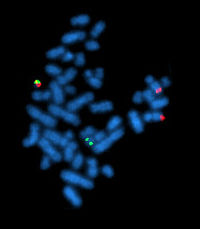
Photo from wikipedia
Clinical and molecular diagnosis of most hematological malignancies including Chronic Myeloid Leukemia (CML) can be accurately made. However, prediction of treatment response and estimation of disease survival period eludes the… Click to show full abstract
Clinical and molecular diagnosis of most hematological malignancies including Chronic Myeloid Leukemia (CML) can be accurately made. However, prediction of treatment response and estimation of disease survival period eludes the currently available tools for patient care. Quantitative expression proteomics can potentially be developed as effective tool to monitor therapy response towards achieving personalized medicine for CML patients. We have over 10 years follow up period for some of the CML patients, and the majorities of them are alive and doing well on Imatinib. On the other hand, a small fraction of the patients were switched to alternative Tyrosine Kinase Inhibitors (TKI) and some underwent bone marrow transplants (BMT). Our follow up results stratified all 37 analyzed newly diagnosed CP-CML patients into 5 distinct cohorts including 52% on Imatinib, 12% on Nilotinib, 9% on Dasatinib, and 15% BMT, while 12% of the patients had disease-related mortality. Kaplan-Meier survival curve showed no significant difference between all patients on TKI and BMT that were alive under a follow up period of 4-11 years compared. On the other hand 3 of 4 patients had disease related deaths less than 2 years of diagnosis. Only one patient survived for almost 10 years (Figure 1). Besides survival analysis, peripheral blood samples obtained from the patients at time of diagnosis were subjected to expression proteome analysis using label-free quantitative liquid chromatography coupled with tandem mass spectrometry (LC-MS/MS). A subset of significantly differentially expressed proteins was able to distinctively discriminate samples into their respective treatment response and disease outcome groups based on unique protein expression signatures (P<0.05 and > 2- ∞- fold change, (Figure 2). Some of the identified proteins were implicated in hematological diseases including CML as potential biomarkers using Ingenuity Pathway Analysis. These protein signatures once validated in larger sample cohorts might be capable of prediction of molecular response, choice of therapy and disease outcome for CML patients. Therefore; allowing for identification of would be high risk patients that might potentially benefit from aggressive treatment at point of diagnosis pre initiation of conventional therapy. Altogether our findings indicate that analysis of panel of protein markers have the potential of clinical utility for prediction of response to therapy, disease survival and objective prognostication of disease outcome, thus bringing personalized medicine closer to CML patients. No relevant conflicts of interest to declare.
Journal Title: Blood
Year Published: 2018
Link to full text (if available)
Share on Social Media: Sign Up to like & get
recommendations!